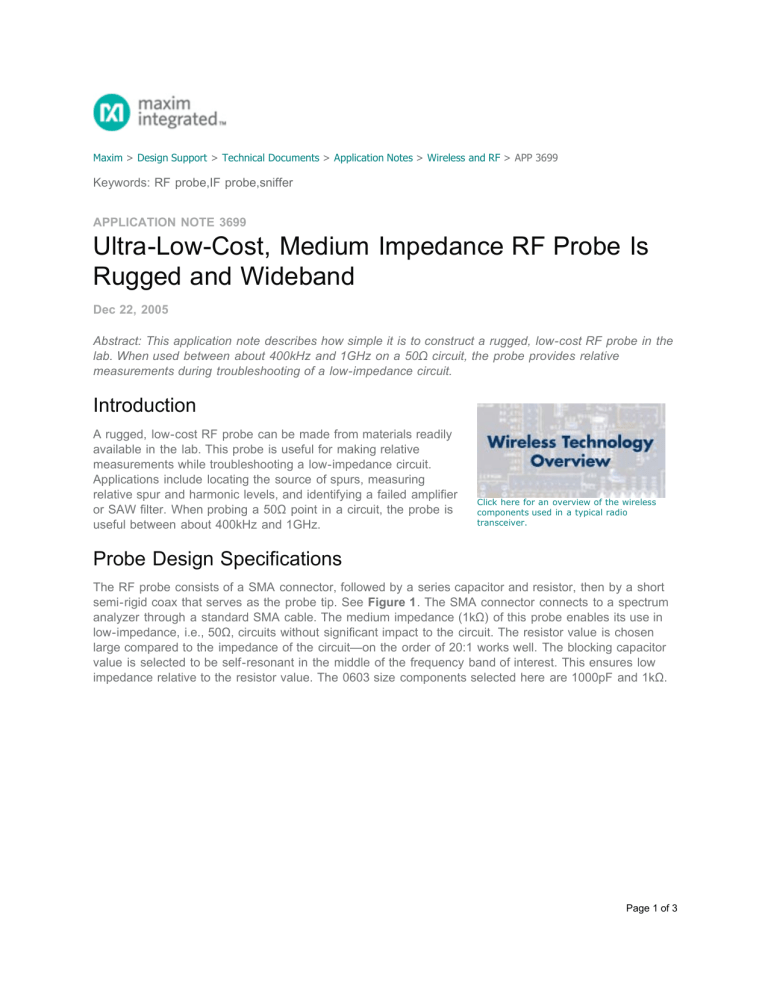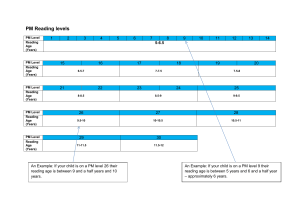
Maxim > Design Support > Technical Documents > Application Notes > Wireless and RF > APP 3699 Keywords: RF probe,IF probe,sniffer APPLICATION NOTE 3699 Ultra-Low-Cost, Medium Impedance RF Probe Is Rugged and Wideband Dec 22, 2005 Abstract: This application note describes how simple it is to construct a rugged, low-cost RF probe in the lab. When used between about 400kHz and 1GHz on a 50Ω circuit, the probe provides relative measurements during troubleshooting of a low-impedance circuit. Introduction A rugged, low-cost RF probe can be made from materials readily available in the lab. This probe is useful for making relative measurements while troubleshooting a low-impedance circuit. Applications include locating the source of spurs, measuring relative spur and harmonic levels, and identifying a failed amplifier or SAW filter. When probing a 50Ω point in a circuit, the probe is useful between about 400kHz and 1GHz. Click here for an overview of the wireless components used in a typical radio transceiver. Probe Design Specifications The RF probe consists of a SMA connector, followed by a series capacitor and resistor, then by a short semi-rigid coax that serves as the probe tip. See Figure 1. The SMA connector connects to a spectrum analyzer through a standard SMA cable. The medium impedance (1kΩ) of this probe enables its use in low-impedance, i.e., 50Ω, circuits without significant impact to the circuit. The resistor value is chosen large compared to the impedance of the circuit—on the order of 20:1 works well. The blocking capacitor value is selected to be self-resonant in the middle of the frequency band of interest. This ensures low impedance relative to the resistor value. The 0603 size components selected here are 1000pF and 1kΩ. Page 1 of 3 Figure 1. Rugged RF probe. Probe Performance Figure 2 shows that the probe's response flatness is 1dB from 400kHz to 1GHz. Resulting measurement error is small compared to normal discrepancies of more than 10dB encountered during troubleshooting, such as when an amplifier fails. Furthermore, removing the coax and using the resistor itself as the probe tip extends the maximum frequency of the probe to 1.9GHz. This approach reduces the resonance that peaks near 3GHz. Although this modified probe is easily damaged, it illustrates the degree to which the coax parasitics affect response flatness. The 11mm length of the coax in Figure 1 is a tradeoff between better RF performance for a shorter coax and improved mechanical robustness for a longer coax with more solder attachment surface. Figure 2. RF-probe frequency response when probing a 50Ω impedance point. The measured power level at the SMA connector on the probe is theoretically -26.4dB below that at the probe tip, assuming a simple voltage-divider of 50Ω/1050Ω. This matches the plot in Figure 2 quite well between 400kHz and 1GHz. The frequency response in Figure 2 is obtained by probing across a 50Ω Page 2 of 3 resistor connected across the output of a calibrated signal generator. Furthermore, an ideal 1kΩ probe loads a 50Ω circuit by only -0.2dB, assuming 1kΩ plus the 50Ω spectrum analyzer in parallel with the 50Ω circuit. Constructing the Probe To assemble the probe shown in Figure 1, first cut a scrap PC board that includes a 50Ω microstrip transmission line with a SMA bulkhead connector. Carefully cut gaps in the strip where a 1000pF capacitor followed by a 1kΩ resistor are soldered. Both components are 0603 size. Cut an 11mm length of 0.086" diameter semi-rigid coax. Expose 2.5mm of the center conductor on one end and 2mm on the other end. The shorter end is the probe tip. After removing the remainder of the strip under the coax, the longer end is bent and soldered to the strip near the resistor. Next, attach the coax by bridging solder from the outer conductor to nearby ground metalization. Use plenty of solder to attach the coax to the PC board robustly. If necessary, use copper tape to bridge the gap. Parallel to the coax, solder a piece of coax center conductor to serve as the ground contact. Add a small glob of solder on the probe and ground tips to help them contact the circuit properly. A similar article appeared in the October, 2004 edition of RF Design. More Information For Technical Support: http://www.maximintegrated.com/support For Samples: http://www.maximintegrated.com/samples Other Questions and Comments: http://www.maximintegrated.com/contact Application Note 3699: http://www.maximintegrated.com/an3699 APPLICATION NOTE 3699, AN3699, AN 3699, APP3699, Appnote3699, Appnote 3699 Copyright © by Maxim Integrated Products Additional Legal Notices: http://www.maximintegrated.com/legal Page 3 of 3



